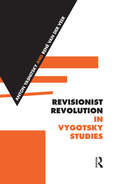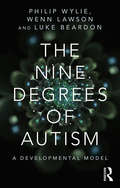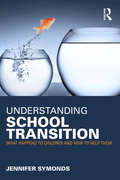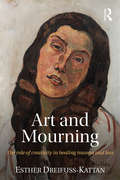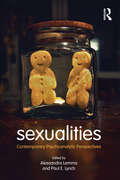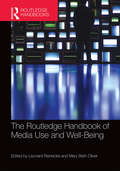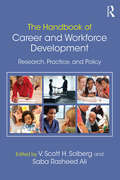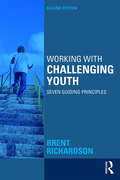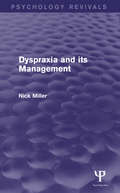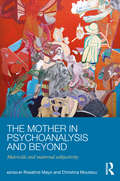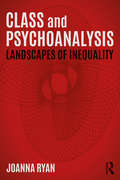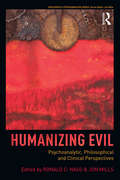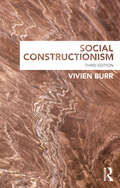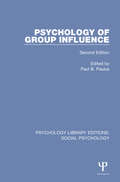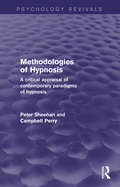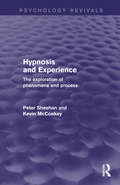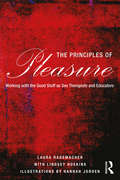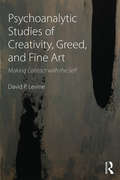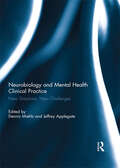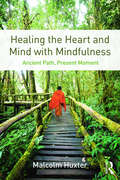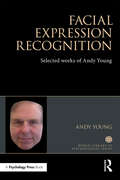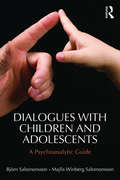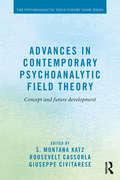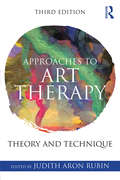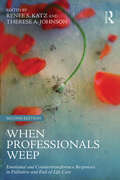- Table View
- List View
Revisionist Revolution in Vygotsky Studies: The State of the Art
by Anton Yasnitsky René Van der VeerRevisionist Revolution in Vygotsky Studies brings together recent critical investigations which examine historical and textual inaccuracies associated with received understandings of Vygotsky’s work. By deconstructing the Vygotskian narrative, the authors debunk the 'cult of Vygotsky', allowing for a new, exciting interpretation of the logic and direction of his theory. The chapters cover a number of important themes, including: The chronology of Vygotsky’s ideas and theory development, and the main core of his theoretical writings Relationships between Vygotskians and their Western colleagues The international reception of Vygotskian psychology and problems of translation The future development of Vygotskian science Using Vygotsky’s published and unpublished writings the authors present a detailed historical understanding of Vygotsky’s thought, and the circumstances in which he worked. It includes coverage of the organization of academic psychology in the Soviet Union, the network of scholars associated with Vygotsky in the interwar period, and the assumed publication ban on Vygotsky’s writings. This volume is the first to provide an overview of revisionist studies of Vygotsky’s work, and is the product of close international collaboration between revisionist scholars. It will be an essential contribution to Vygotskian scholarship, and of great interest to researchers in the history of psychology, history of science, Soviet/Russian history, philosophical psychology and philosophy of science.
The Nine Degrees of Autism: A Developmental Model for the Alignment and Reconciliation of Hidden Neurological Conditions
by Philip Wylie Luke Beardon Wenn LawsonThe Nine Degrees of Autism presents a much-needed positive tool for understanding the developmental process of autism, and to facilitate the improved mental health and well-being of individuals on the spectrum. The ground-breaking model charts nine distinct stages of development - from pre-identification, to learning to live with changes in self-image following a late diagnosis, through to self-acceptance and wellbeing. Using the model as a framework each chapter focuses on a particular stage of the process. Experts provide personal insights into the environmental and societal challenges faced by individuals with autism, and dispel a number of popular misconceptions. The positive developmental model described in this book will encourage people on the Spectrum to accept themselves by focusing on their gifts rather than weaknesses, and to avoid identifying with negative medical classifications. The developmental process which the authors describe is also applicable to other ‘hidden’ neurological conditions such as Dyslexia, Dyspraxia, Aphasia, and ADHD. The book should be read by anyone who wants to understand the real nature and experience of autism and will also be essential reading for a range of professionals seeking to work more effectively with individuals on the spectrum.
Understanding School Transition: What happens to children and how to help them
by Jennifer SymondsSchool transition is a life changing event for children - they are rarely faced with such a powerful set of personal and social changes. These underpin the immediate and longer term wellbeing of children, peer groups, teachers and schools. Understanding School Transition provides a most comprehensive, international review of this important area, complete with practical advice on what practitioners can do to support children’s wellbeing, motivation and achievement. Offering an accessible introduction to children’s psychology at transition, Understanding School Transition explores transition as a status passage, what we really mean by wellbeing, and the ways in which children adapt to new environments. Key chapters focus on: ? Understanding stress and anxiety Children’s hopes, fears and myths at transition Parents’ and teachers’ influence and role Children’s relationships with peers as they change schools Children’s personal and collective identities Motivation, engagement and achievement Supporting the most vulnerable children ? Crucially, it advises how you can help children through implementing transition interventions and evaluating their success in your own school. Illustrated by case studies of experiences in real schools, Understanding School Transition will be essential reading for all training and practising teachers, as well as transition and subject specialists, who want to better understand and influence what happens to children at this critical stage.
Art and Mourning: The role of creativity in healing trauma and loss
by Esther Dreifuss-KattanArt and Mourning explores the relationship between creativity and the work of self-mourning in the lives of 20th century artists and thinkers. The role of artistic and creative endeavours is well-known within psychoanalytic circles in helping to heal in the face of personal loss, trauma, and mourning. In this book, Esther Dreifuss-Kattan, a psychoanalyst, art therapist and artist - analyses the work of major modernist and contemporary artists and thinkers through a psychoanalytic lens. In coming to terms with their own mortality, figures like Albert Einstein, Louise Bourgeois, Paul Klee, Eva Hesse and others were able to access previously unknown reserves of creative energy in their late works, as well as a new healing experience of time outside of the continuous temporality of everyday life. Dreifuss-Kattan explores what we can learn about using the creative process to face and work through traumatic and painful experiences of loss. Art and Mourning will inspire psychoanalysts and psychotherapists to understand the power of artistic expression in transforming loss and traumas into perseverance, survival and gain. Art and Mourning offers a new perspective on trauma and will appeal to psychoanalysts and psychotherapists, psychologists, clinical social workers and mental health workers, as well as artists and art historians.
Sexualities: Contemporary Psychoanalytic Perspectives
by Alessandra Lemma Paul E. LynchSexualities: Contemporary Psychoanalytic Perspectives presents a broad selection of contemporary psychoanalytic thinking on sexuality from a wide range of psychoanalytic traditions. Sexuality remains at the heart of much psychoanalytic theory and practice but it is a complex and controversial subject. Edited by Alessandra Lemma and Paul E. Lynch, this volume includes a range of international contributions that examine contemporary issues and trace common themes needed to understand any sexuality, including the basics of sexuality, and the myriad ways in which sexuality is lived. The clinical examples provided here demonstrate contemporary psychoanalytic techniques that uncover meanings that are both fresh and enlightening, and address heterosexuality, homosexuality, gender, and perversion from a psychoanalytic perspective. Divided into four parts, the book includes the following: Historical context Foundational concepts: Contemporary elaborations Homosexuality Perversion revisited Throughout Sexualities: Contemporary Psychoanalytic Perspectives the reader will find psychoanalytic wisdom that is transferrable to work with patients of all sexualities, and will see that the essentials of sexuality may be more similar than they are different for homo- and hetero-sexuality. Psychoanalysts and psychoanalytic psychotherapists, as well as academics interested in the subjects of psychoanalysis, gender, sexuality, or homosexuality will find this book an invaluable resource. Alessandra Lemma, PhD is Director of the Psychological Therapies Development Unit at the Tavistock and Portman NHS Foundation Trust. She is a Fellow of the British Psychoanalytic Society and Visiting Professor in the Psychoanalysis Unit, University College London. She is a Consultant Adult Psychotherapist at the Portman Clinic where she specializes in working with transsexuals. She has published extensively on psychoanalysis, the body and trauma. Paul E. Lynch, MD is on the faculty of the Boston Psychoanalytic Society and Institute, the Massachusetts Institute for Psychoanalysis, and the China American Psychoanalytic Alliance. He teaches about psychoanalysis, gender, and sexuality, and has been a popular speaker on issues of homosexuality and psychoanalysis. He is also a Clinical Instructor of Psychiatry at the Tufts University School of Medicine.
The Routledge Handbook of Media Use and Well-Being: International Perspectives on Theory and Research on Positive Media Effects
by Mary Beth Oliver Leonard ReineckeThe Routledge Handbook of Media Use and Well-Being serves as the first international review of the current state of this fast-developing area of research. The volume provides a multifaceted perspective on the beneficial as well as the detrimental effects of media exposure on psychological health and well-being. As a "first-mover," it will define the field of media use and well-being and provide an essential resource for research and teaching in this area. The volume is structured along four central considerations: Processes presents concepts that provide a theoretical bridge between media use and well-being, such as psychological need satisfaction, recovery from stress and strain, self-presentation and self-enhancement, or parasocial interactions with media characters, providing a comprehensive understanding of the underlying processes that drive psychological health and well-being through media. Moderators examines both risk factors that promote negative effects on well-being and protective factors that foster positive media effects. Contexts bridges the gap between theory and "real life" by illustrating how media use can influence well-being and satisfaction in very different life domains, covering the full spectrum of everyday life by addressing the public, private, and work spheres. Audiences takes a look at the influence of life phases and life situations on the interplay of media use and well-being, questioning whether various user groups differ with regard to the effects of media exposure. Bringing together the expertise of outstanding international scholars from multiple disciplines, including communication, media psychology, social psychology, clinical psychology, and media education, this handbook sheds new light on the role of media in influencing and affecting emotions.
The Handbook of Career and Workforce Development: Research, Practice, and Policy
by V. Scott H. Solberg Saba Rasheed AliThe Handbook of Career and Workforce Development provides educators, researchers, and policy makers with information on evidence-based programs and activities. Chapters describe ways that current research can be used to promote the design of more effective career development programs and services at local, state, and national levels. Promising career development practices applicable to a range of settings and special populations are identified, as are strategies for communicating evidence in ways that influence career and workforce development public policy. The Handbook of Career and Workforce Development can be used by policy makers and grant program officers to identify key career development ingredients that should be considered in proposals; researchers seeking to make their career development research relevant and practical; and practitioners implementing or advocating for career development programs and services.
Working with Challenging Youth: Seven Guiding Principles
by Brent RichardsonWorking with Challenging Youth, Second Edition is a practical, reader-friendly guide through the pitfalls and problems that arise when working with at-risk youth. As in the first edition, the new Working with Challenging Youth builds on a solid theoretical base in reality therapy, cognitive-behavioral therapy, solution-focused therapy, systems theory, and humanistic philosophy to answer the question "What distinguishes the really effective professionals from the rest?" This second edition includes new sections on specialized, evidence-based approaches such as dialectical behavior therapy, mindfulness, collaborative problem-solving, motivational interviewing, and multisystemic therapy. This book also offers 7 guiding principles and 50 specific lessons to help bridge the gap between helping professionals and youth.
Dyspraxia and its Management (Psychology Revivals)
by Nick MillerDyspraxia is a disorder of voluntary, purposeful, learned movement and is one of the most common sequelae of stroke, head-injury, neoplasm and abnormal ageing. It is also a major complicating factor in the assessment and treatment of acquired language, visual-spatial and other movement disorders. Dyspraxics are found not only in specialist neurological units, but also in rehabilitation centres, general medical and surgical wards, geriatric units and in the community. Despite this there was little systematic discussion of dyspraxia in major texts on stroke, head injury, rehabilitation or movement disorders at the time. Originally published in 1986, one aim of this book was to correct the imbalance in the attention paid to the disorder. The emphasis of the book is practical, dealing with the recognition and assessment of dyspraxic dysfunction, and guidelines and issues in its remediation. Theoretical issues are covered in relation to their bearing on clinical management. It was the standard textbook on the topic for many years and directly relevant at the time to clinicians in the fields of clinical psychology, occupational therapy and physiotherapy, speech therapy, neurology and geriatrics.
The Mother in Psychoanalysis and Beyond: Matricide and Maternal Subjectivity
by Rosalind Mayo Christina MoutsouThe question of what it means to be a mother is a very contentious topic in psychoanalysis and in wider society. The Mother in Psychoanalysis and Beyond explores our relationship to the maternal through psychoanalysis, philosophy, art and political and gender studies. Over two years, a group of psychotherapists and members of the public met at the Philadelphia Association for a series of seminars on the Maternal. In the discussions that followed, a chasm opened up slowly and painfully between the idealised longings and fantasies we all share and the realities of maternal experiences: here were met the great silences of love, loss, longing, memories, desire, hatred and ambivalence. This book is the result of this bringing together in conversation and reflections of what so often seems unsayable about the Mother. It examines how issues of personal and gender identity are shaped by the ideals of separation from the mother, the fears and anxiety of merging with the mother, and how this has often led, in psychoanalysis and society, to holding mothers responsible for a variety of personal and social ills and problems in which maternal vulnerability is denied and silenced. There are two main themes running throughout the book: Matricide and Maternal Subjectivity. On the theme of matricide, several contributors discuss the ways in which the discourse and narratives of the Mother have been silenced on a sociocultural level and within psychoanalysis and philosophy in favour of discourses that promote independence, autonomy, power and the avoidance and denial of our fundamental helplessness and vulnerability. On the theme of maternal subjectivity, several chapters look at the actual experience of mothering and/or our relationship to our mother, to highlight the ways in which the maternal is intimately connected with human subjectivity. The Mother in Psychoanalysis and Beyond provides new and provocative thinking about the maternal and its place in various contemporary discourses. It will appeal to psychoanalysts, psychotherapists and psychologists of different schools, scholars and advanced students of art, gender studies, politics and philosophy as well as anyone interested in maternity studies and the relationship between the maternal and human subjectivity.
Class and Psychoanalysis: Landscapes of Inequality
by Joanna RyanDoes psychoanalysis have anything to say about the emotional landscapes of class? How can class-inclusive psychoanalytic projects, historic and contemporary, inform theory and practice? Class and psychoanalysis are unusual bedfellows, but this original book shows how much is to be gained by exploring their relationship. Joanna Ryan provides a comprehensively researched and challenging overview in which she holds the tension between the radical and progressive potential of psychoanalysis, in its unique understandings of the unconscious, with its status as a mainly expensive and exclusive profession. Class and Psychoanalysis draws on existing historical scholarship, as well as on the experiences of the author and other writers in free or low-cost projects, to show what has been learned from transposing psychoanalysis into different social contexts.It book describes how class, although descriptively present, was excluded from the founding theories of psychoanalysis, leaving a problematic conceptual legacy that the book attempts to remedy. Joanna Ryan argues for an interdisciplinary approach, drawing on modern sociological and psychosocial research to understand the injuries of class, the complexities of social mobility, and the defenses of privilege. She brings together contemporary clinical writings with her own research about class within therapy relationships to illustrate the anxieties, ambivalences and inhibitions surrounding class, and the unconsciousness with which it may be enacted. Class and Psychoanalysis breaks new ground in providing frameworks for a critical psychoanalysis that includes class. It will be of interest to anyone who wishes to think psychoanalytically about how we are intimately formed by class, or who is concerned with the inequalities of access to psychoanalytic therapies, or with the future of psychoanalysis.
Humanizing Evil: Psychoanalytic, Philosophical and Clinical Perspectives (Philosophy and Psychoanalysis)
by Ronald C Naso Jon MillsPsychoanalysis has traditionally had difficulty in accounting for the existence of evil. Freud saw it as a direct expression of unconscious forces, whereas more recent theorists have examined the links between early traumatic experiences and later ‘evil’ behaviour. Humanizing Evil: Psychoanalytic, Philosophical and Clinical Perspectives explores the controversies surrounding definitions of evil, and examines its various forms, from the destructive forces contained within the normal mind to the most horrific expressions observed in contemporary life. Ronald Naso and Jon Mills bring together an international group of experts to explore how more subtle factors can play a part, such as conformity pressures, or the morally destabilizing effects of anonymity, and show how analysts can understand and work with such factors in clinical practice. Each chapter is unified by the view that evil is intrinsically linked to human freedom, regardless of the gap experienced by perpetrators between their intentions and consequences. While some forms of evil follow seamlessly from psychopathology, others call this relationship into question. Rape, murder, serial killing, and psychopathy show very clear links to psychopathology and character whereas the horrors of war, religious fundamentalism, and political extremism resist such reductionism. Humanizing Evil is unique in the diversity of perspectives it brings to bear on the problem of evil. It will be essential reading for psychoanalysts, psychotherapists, philosophers, and Jungians. Because it is an integrative depth-psychological effort, it will interest general readers as well as scholars from a variety of disciplines including the humanities, philosophy, religion, mental health, criminal justice, political science, sociology, and interdisciplinary studies. Ronald Naso, Ph.D., ABPP is psychoanalyst and clinical psychologist in independent practice in Stamford, CT. The author of numerous papers on psychoanalytic topics, he is an associate editor of Contemporary Psychoanalytic Studies, and contributing editor of Division/Review and Journal of Psychology and Clinical Psychiatry. His book, Hypocrisy Unmasked: Dissociation, Shame, and the Ethics of Inauthenticity, was published by Aronson in 2010. Jon Mills, Psy.D., Ph.D., ABPP is a philosopher, psychoanalyst, and clinical psychologist. He is Professor of Psychology & Psychoanalysis at Adler Graduate Professional School, Toronto. A 2006, 2011, and 2013 Gradiva Award winner, he is Editor of two book series in psychoanalysis, on the Editorial Board for Psychoanalytic Psychology, and is the author and/or editor of thirteen books including his most recent works, Underworlds: Philosophies of the Unconscious from Psychoanalysis to Metaphysics, and Conundrums: A Critique of Contemporary Psychoanalysis, which won the Goethe Award for best book in 2013.
Social Constructionism
by Vivien BurrNow in its third edition, this successful book introduces students to the area of social science theory and research known as social constructionism. Using a variety of examples from everyday experience and from existing research in areas such as personality, sexuality and health, it clearly explains the basic theoretical assumptions of social constructionism. Key debates, such as the nature and status of knowledge, truth, reality and the self are given in-depth analysis in an accessible style. Drawing on a range of empirical studies, the book clearly defines the various different approaches to social constructionist research and explores the theoretical and practical issues involved. While the text is broadly sympathetic to social constructionism, it also adopts a critical perspective to the material, addressing its weaknesses and, in the final chapter, subjecting the theory itself to a more extensive critique. New to this edition: Extended coverage of the relationship between 'mainstream' psychology and social constructionism and how the two fields can engage with each other. An exploration of the rise and popularity of neuroscience and the challenge it poses to social constructionism. New material on the field of psychosocial studies. Updated coverage of existing key issues such as age and sexuality, and inclusion of more recently emerging issues (e.g. status and role of affect). Updated discussion of key social constructionist contributors, with revised references. Updated chapter on research methods, including more on narrative and critical narrative analysis, and personal construct methods. The third edition of Social Constructionism extends and updates the material covered in previous editions and will be an invaluable and informative resource for undergraduate and postgraduate students across the social and behavioural sciences.
Psychology of Group Influence: Second Edition (Psychology Library Editions: Social Psychology)
by Paul B. PaulusOriginally published in 1989, this title showcased new developments, providing a systematic and in-depth overview of some of the basic issues in the field of group psychology. Subject areas range from basic group processes to complex interactive phenomena. There are international contributions, with chapters covering the latest developments in the field at the time. The volume provided students and professionals with a comprehensive, coherent, and interrelated picture of the broad scope of group influence processes. The volume was motivated by the belief that group psychology is a central and important activity for social psychology.
Methodologies of Hypnosis: A Critical Appraisal of Contemporary Paradigms of Hypnosis (Psychology Revivals)
by Peter W. Sheehan Campbell W. PerryOriginally published in 1976, this title looks closely at the current nature of controls in hypnosis research at the time and tries to assess what they contributed to our knowledge of hypnosis. Specifically, the book analyses the contributions to our understanding of hypnotic phenomena offered by the application of six contemporary methodologies, or paradigms, of hypnosis. The primary concern is with those paradigms that are experimental, rather than clinical, in orientation, and which had emerged over the previous decade as coherent programmatic collections of procedural strategies, all of them associated with distinct and important views of how hypnotic behaviour can best be explained.
Hypnosis and Experience: The Exploration of Phenomena and Process (Psychology Revivals)
by Peter W. Sheehan Kevin M. McConkeyThe subject of hypnosis has not lost any of its ability to fascinate and intrigue – and this holds equally true for both the layperson and the student of hypnotic behavior. Phenomena of hypnosis range from simple tasks involving ideomotor response to more complex tasks involving substantial distortions of perceived reality such as age regression, hallucination, and amnesia. Obviously, with a topic so diverse and so interesting, there are plenty of books around. Originally published in 1982, what makes this title stand out is the authors’ focus: instead of trying to survey the whole field and evaluate the full spectrum of theories about hypnosis, they hone in on specific points of view with the aim of illustrating the nature of hypnotic phenomena.
The Principles of Pleasure: Working with the Good Stuff as Sex Therapists and Educators
by Laura Rademacher Lindsey HoskinsThere are tremendous benefits to discussing the subject of sexual and emotional pleasure with clients, and this book addresses the challenges and misconceptions of doing just that. Laura Rademacher and Lindsey Hoskins teach the skills necessary for mental health professionals and sex educators to build competence in this work with their clients. Readers get techniques to implement in therapeutic, clinical, and educational settings, and learn how to examine pleasure in ways that are currently lacking from academic work on sexual health. This book covers skills for working with populations of all orientations and gender expressions. Language and phrasing for addressing pleasure issues in a wide variety of educational or therapeutic settings is also provided. Information about sexual lubrication and sex toys that is rarely taught in professional training programs is included, as well as how to appropriately incorporate information about these important sexual tools into your work. Issues such as abstinence, sexual orientation, couple therapy, and sexual education will be discussed outside of the standard medical model of sex therapy. The Principles of Pleasure will help you feel relaxed and confident while moving clients and students closer to their pleasure goals, and provides the evidence to back up the importance of talking and teaching about pleasure, should you need to justify this work.
Psychoanalytic Studies of Creativity, Greed, and Fine Art: Making Contact with the Self
by David P LevineThroughout the history of psychoanalysis, the study of creativity and fine art has been a special concern. Psychoanalytic Studies of Creativity, Greed and Fine Art: Making Contact with the Self makes a distinct contribution to the psychoanalytic study of art by focusing attention on the relationship between creativity and greed. This book also focuses attention on factors in the personality that block creativity, and examines the matter of the self and its ability to be present and exist as the essential element in creativity. Using examples primarily from visual art David Levine explores the subjects of creativity, empathy, interpretation and thinking through a series of case studies of artists, including Robert Irwin, Ad Reinhardt, Susan Burnstine, and Mark Rothko. Psychoanalytic Studies of Creativity, Greed and Fine Art explores the highly ambivalent attitude of artists toward making their presence known, an ambivalence that is evident in their hostility toward interpretation as a way of knowing. This is discussed with special reference to Susan Sontag's essay on the subject of interpretation. Psychoanalytic Studies of Creativity, Greed and Fine Art contributes to a long tradition of psychoanalytically influenced writing on creativity including the work of Deri, Kohut, Meltzer, Miller and Winnicott among others. It will be of interest to psychoanalysts, psychoanalytic psychotherapists, historians and theorists of art.
Neurobiology and Mental Health Clinical Practice: New Directions, New Challenges
by Dennis Miehls and Jeffrey ApplegateThis book illustrates the current findings of interpersonal neurobiology that inform knowledge building and clinical practice. Contributions cover an impressive range of material including how neurobiology interfaces with clinical work with children, individuals with substance abuse issues, couples and clients with trauma histories. Leading mental health clinician-scholars describe path-breaking explorations at the neurobiological frontiers of 21st century clinical theory and practice. Representing the fields of social work, psychology and psychiatry, these authors creatively apply research findings from the ongoing revolution in social and behaviour neuroscience to a diverse array of clinical issues. Contributions include elaborations of theory (the evolving social brain; new directions in attachment, affect regulation and trauma studies); practice (neurobiologically informed work with children, adults, couples and in the conduct of supervision); and emerging neuroscientific perspectives on broader mental health issues and concerns (substance abuse; psychotropic medications; secondary traumatic stress in clinicians; the neurodynamics of racial prejudice; the dangers of forfeiting humanism to our current romance with the biological). Together, these chapters equip readers with state-of-the-art knowledge of the manner in which new understandings of the brain inform and shape today’s professional efforts to heal the troubled mind. This book was originally published as a special issue of Smith College Studies in Social Work.
Healing the Heart and Mind with Mindfulness: Ancient Path, Present Moment
by Malcolm HuxterHealing the Heart and Mind with Mindfulness is a practical book that provides strategies using mindfulness to manage stress, anxiety and depression, as well as ways to cultivate psychological wellbeing. Uniquely, it combines a traditional Buddhist approach to mindfulness with contemporary psychology and current perspectives. Drawing on the author’s many years of clinical experience as a psychologist as well as his personal experience in Buddhist meditation practices, it outlines how the Buddha’s four applications of mindfulness can provide a pathway to psychological wellbeing, and how this can be used personally or with clinical populations. This accessible, user friendly book provides strategies for healing the heart and mind. Malcolm Huxter introduces mindfulness as it is presented in Buddhist psychology and guides the reader through meditations in a systematic way. The practices are clearly explained and supported by relevant real life stories. Being aware that mindfulness and meditation are simple but not easy, Huxter guides the reader from the basics of mindfulness and meditation through to the more refined aspects. He provides a variety of different exercises and guided meditations so that individuals are able to access what suits them. The guided meditations can be streamed or accessed as free audio downloads. Healing the Heart and Mind with Mindfulness is aimed at anyone who wishes to use mindfulness practices for psychological freedom. This book provides insight and clarity into the clinical and general applications of Buddhist mindfulness and will be of interest to mental health practitioners, students of mindfulness, professional mindfulness coaches and trainers, researchers and academics wishing to understand Buddhist mindfulness and the general public.
Facial Expression Recognition: Selected works of Andy Young (World Library of Psychologists)
by A W YoungIn the World Library of Psychologists series, international experts themselves present career-long collections of what they judge to be their finest pieces - extracts from books, key articles, salient research findings, and their major theoretical and practical contributions. This volume of self-selected papers recognises Andy Young’s major contribution to the study of face perception, for which he received the BPS Lifetime Achievement Award in 2013. Focusing on his work in facial expression recognition, a specially written introduction gives an overview of his work and contextualises the selection in relation to developments in the field during this time. Divided into five distinct sections, the book covers work on both theoretical and experimental approaches to facial expression recognition, neuropsychology, functional brain imaging, and applications of research. This book will be of great interest to students and researchers of cognitive psychology or neuropsychology interested in face perception. It will also appeal to those with an interest in the highly varied applications of the research and provide insight into a number of clinical disorders.
Dialogues with Children and Adolescents: A Psychoanalytic Guide
by Björn Salomonsson Majlis Winberg-SalomonssonPsychoanalytic work with children is popular, but the sophisticated language used in psychoanalytic discourse can be at odds with how children communicate, and how best to communicate with them. Dialogues with Children and Adolescents: A Psychoanalytic Guide shows how these aims can be achieved for the most effective clinical outcome with children from infancy up to late adolescence. Björn Salomonsson and Majlis Winberg Salomonsson draw on extensive case material which reveals the essence of communication between child and therapist. They enfranchise the patient of all ages as an equal participant in the therapeutic relationship. Presented in letter form the cases contain no professional terms. Only the final chapter contains theoretical commentaries applicable to each case. These terms and theories help to explain a child’s behaviour, the analyst’s technique and the background to the disorder. This is new creative development in child therapy and analysis which is written in a very accessible style. Dialogues with Children and Adolescents will be essential reading for beginners in psychoanalytic work with children and will cast a fresh light on such work for more experienced clinicians. It will also appeal to the non-professional lay reader.
Advances in Contemporary Psychoanalytic Field Theory: Concept and Future Development (Psychoanalytic Field Theory Book Series)
by S. Montana Katz, Roosevelt Cassorla and Giuseppe CivitareseField Theory is a powerful and growing paradigm within psychoanalysis, but has previously been split between various schools of thought with little overlap. In this book, a distinguished group of contributors from across all perspectives on Field Theory examine its uniting factors and set out future developments and directions for the paradigm within psychoanalysis. Advances in Contemporary Psychoanalytic Field Theory represents the work developed for the first international meeting of the International Field Theory Association. Founded in 2015 to offer a community for those interested in psychoanalytic field theory and promote its understanding and further development, IFTA recognizes all models of psychoanalytic field theory and seeks to foster communication amongst psychoanalysts working in different models, languages and parts of the world. At the first ever meeting of IFTA, an international group of psychoanalysts participated in a roundtable discussion of the different contemporary models of psychoanalytic field theory. Each participant wrote a paper in advance of the meeting, which were all shared among the group beforehand and then discussed together. These feature as the chapters in this volume, whilst a thirteenth member offers a unifying overview of all the papers. Each chapter provides new, contemporary ways of approaching field theory. Key excerpts from the discussion of the meeting are also featured throughout to give a flavour of the collaborative efforts of the participants. The emphasis of this book is on generating mutual understanding of the different models of field theory, their underlying concepts, and heuristic principles. Drawing on insights from literature, critical theory and philosophy as well as psychoanalysis, this book sets out a program for the future of Field Theory. Advances in Contemporary Psychoanalytic Field Theory will appeal to psychoanalysts and mental health care practitioners as well as academicians in philosophy, psychology and literature.
Approaches to Art Therapy: Theory and Technique
by Judith Aron RubinThe third edition of Approaches to Art Therapy brings together varied theoretical approaches and provides a variety of solutions to the challenge of translating theory to technique. In each chapter, the field's most eminent scholars provide a definition of and orientation to the specific theory or area of emphasis, showing its relevance to art therapy. The third edition includes many new chapters with material on a wide variety of topics including contemplative approaches, DBT, neuroscience, and mentalization while also retaining important and timeless contributions from the pioneers of art therapy. Clinical case examples and over 100 illustrations of patient artwork vividly demonstrate the techniques in practice. Approaches to Art Therapy, 3rd edition, is an essential resource in the assembly of any clinician's theoretical and technical toolbox, and in the formulation of each individual's own approach to art therapy.
When Professionals Weep: Emotional and Countertransference Responses in Palliative and End-of-Life Care (Series in Death, Dying, and Bereavement)
by Renee S. Katz Therese A. JohnsonWhen Professionals Weep speaks to the humbling and often transformational moments that clinicians experience in their careers as caregivers and healers—moments when it is often hard to separate the influence of our own emotional responses and worldviews from the patient’s or family’s. When Professionals Weep addresses these poignant moments—when the professional's personal experiences with trauma, illness, death, and loss can subtly, often stealthily, surface and affect the helping process. This edition, like the first, both validates clinicians’ experiences and also helps them process and productively address compassion fatigue, burnout, and secondary traumatic stress. New material in the second edition includes increased emphasis on the burgeoning fields of hospice and palliative care, organizational countertransference, mindfulness, and compassionate practice. It includes thought-provoking cases, self-assessments, and exercises that can be used on an individual, dyadic, or group basis. This volume is an invaluable handbook for practitioners in the fields of medicine, mental health, social work, nursing, chaplaincy, the allied health sciences, psychology, and psychiatry.
